 |
| Category: Flags |

|
|
|
|
|
| Colours
from other Countries |
| Allied countries of the
Commonwealth also have the same or similar traditions. . .
Colours of some New
Zealand Regiments
|
|
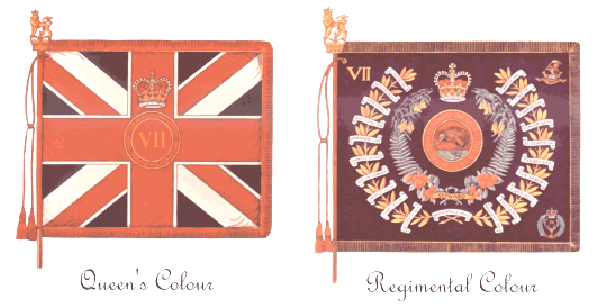
|
|
The Queen's and Regimental Colours of
New Zealand's Wellington
Regiment, a Unit that has historical links
with Australia through ANZAC |
| Canadian
Colours |
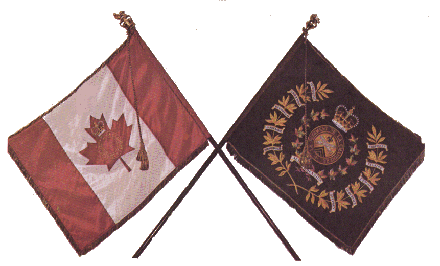
|
|
Colours of
Le
Régiment de la Chaudière (Canada)
|
| Canadian Forces
Administrative Orders govern the design of colours. The Queen's Colour
is based upon the national flag and incorporates St. Edward's Crown and
the Royal Cypher 'E II R'.
The Regimental Colour basic design
will vary depending on whether it represents a Guards, Highland or
Infantry Regiment. In Guards Regiments the reverse is true; the National
Flag forms the basis for the Regimental Colours, with the badge of one
of the companies superimposed rather than the Royal Cypher; the central
device of the Queen's Colour is the same as that of the Governor
General's personal standard.
Battle Honours displayed on a
Regimental Colour include the honours awarded to the unit for service
prior to the First World War; a maximum of ten honours awarded during
each World War; and a maximum of two honours awarded during the Korean
conflict between 1950 and 1953.
Foot Guards Regiments are required to
emblazon their battle honours on both the Queen's and Regimental
Colours. Battle honours awarded to Rifle regiments are emblazoned on the
appointments of that regiment, most commonly on the drums carried by the
band or the cap badge of the Regiment. (Rifle
Regiments in Canada traditionally do not carry Colours as they were
originally ranger or scout units who had to operate without any fanfare,
almost in secrecy).
At Le
Régiment de la Chaudière, the
Regimental Colours are highly esteemed and respected. The Colours are
exposed in the Musée du Régiment at the Lévis Garrison. They are
deployed during regimental parades and at the officer's annual
Regimental Mess Dinner. As the Colours are carried along, all military
personnel must stand at attention and salute them. It is now a tradition
at our unit that during regimental parades the senior Lieutenant carries
the Royal Colour and acts as the Colours Guard Commander. The junior
Lieutenant is designated to carry the Regimental Colour. The Guard is
also composed of a Master Warrant Officer or Warrant Officer and two Sergeants.
Only the officers given the task can carry and manipulate the
Colours.
After every regimental parade, as
required by the tradition, the Colours Guard Commander offers a Calvados
(apple brandy)
to the guard members and all toast to:
"A
LA NORMANDIE" in
memory of D Day, June 6 1944
The Canadian battle honour system draws
on the rich heritage of the British forces. British Battle Honours
originated with the army, which granted its first honour in 1695 and
subsequently recognized honours as
early as 1513 to the Corps of Gentlemen-at-Arms. |
|
The Black Watch Of
Canada |
|
 |
|
|
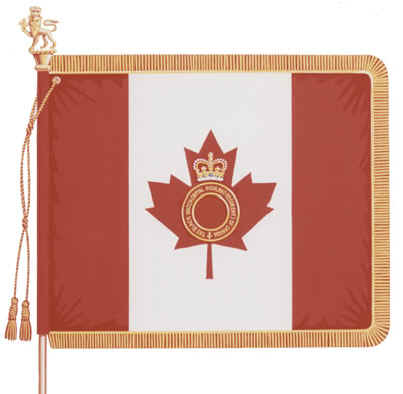 |
Each
of our infantry battalions carries a Queen's (or King's) Colour and a
Regimental Colour. These two colours, known as a stand
of colours, represent the heart of
a regiment. The Queen's Colour symbolizes the regiment's loyalty
to the monarch, and the Regimental Colour symbolizes the regiment's
veneration of it's past. This colour has embroidered on it selected
battle honours from its past, along with its name and badges. The
Queen's Colour has embroidered on it the Crown and name of the regiment,
and uses the Canadian Maple Leaf Flag as a background. Both Colours are
carried by junior officers and are escorted by three senior NCOs. The
Queen's Colour currently in use by The Black Watch was presented by HM,
The Queen Mother at St. Hubert in 1974. The Regimental Colour was
presented by her at Molson Stadium in 1962 when all three Black Watch
battalions were presented new stands of colours as part of our 100th
anniversary celebration. Once colours are retired after 15-25 years of
service, they are retired to the Church
of St. Andrew and St. Paul, where over a dozen colours from The
Black Watch's history may be seen. New colours are presented in a solemn
and impressive ceremony, where the old colours are marched off for the
last time and the new colours are consecrated by the Regimental Padre. |
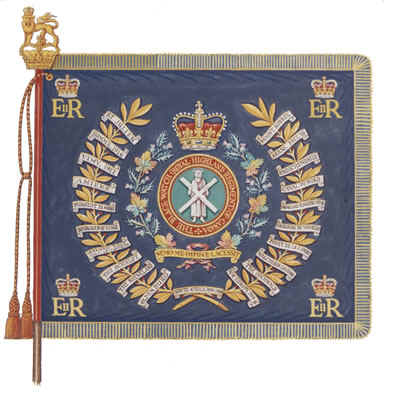 |
| The
Queen's York Rangers (Royal
Canadian Armoured Corps) |
|
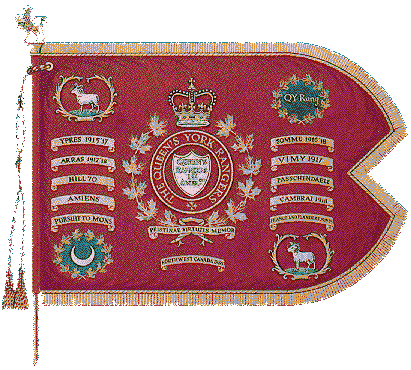
|
|
The Regiment bears
twenty-seven Battle Honours. Honours in bold are emblazoned on the
guidon.
| North West Canada 1885 |
Vimy 1917 |
St. Quentin |
| Ypres
1915/17 |
Hill 70 |
Amiens |
| Festubert 1915 |
Pilchkem |
Scarpe |
| Mount Sorrel 1916 |
Langemarck |
Drocourt-Queant |
| Somme
1916/18 |
Menin Road |
Hindenburg Line |
| Flers-Courcelette |
Polygon Wood |
Canal du Nord |
| Thiepval |
Broodseinde |
Cambrai 1918 |
| Ancre Heights |
Poelcapelle |
Pursuit to Mons |
| Arras
1917/18 |
Passchendaele |
France and Flanders
1915/18 |
A quick glance at their Battle Honours
will show why this Unit can stand alongside Aussies at any time. They
were there beside us at Ypres, Poelcapelle, Passchendaele, Menin Road
and more.
|
|
Historic Canadian
Colours |
|
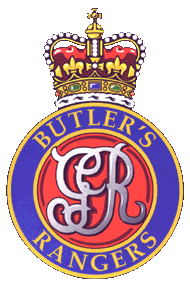
|
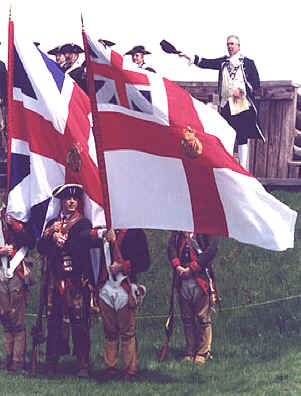 |
|
http://www.iaw.on.ca/~awoolley/brang/brcolour.html |
Butler's Rangers. A
Re-enactment group in Canada.
Shown are their "Colours"
which are faithful reproductions of the originals.
Note the Union Flag is the original
square type, without a representation for Ireland. 
The term "Regimental Colours" is
descriptive of the infantry flags which evolved in the British Army,
and refers to the two flags of a battalion, the senior of which is
called the Queen's (or King's) Colour, and the junior, the Regimental
Colour. Together they are referred to as a "stand" of
colours.
The design and form of colours of the Canadian
Forces today traces its history to a document entitled
"Regulations for the uniform Clothing of the Marching Regiments
of Foot, their Colours, Drums, Bells of Arms, and Camp Colours,
1747." In general, the regulations put a stop to a former
practice wherein Colonels of regiments had placed a device or coat of
arms on colours and appointments of regiments under their command. The
new instructions gave the design of colours as:
-
The King's, or First Colour, of every Regiment or
Battalion to be the Great Union.
The Second Colour to be the colour of the Facings of the Regiment
with the Union in the upper canton...
-
In the centre of each Colour is to be painted or embroidered in gold
Roman characters the number of the Rank of the Regiment within a
wreath of Roses and Thistles on the same stalk...
This regulation of design, with modifications, is
still the basis of the design of Regimental Colours in the British
Army today. The design of colours of the Canadian Army, although
basically following the same rules as the British, now use the
National Flag of Canada as the Queen's Colour (with the exception of
Regiments of Guards).
The use of the term "King's Colour" in the
1747 regulations is the first recorded instance where it is used to
describe the "First Colour" of a regiment.
Today, it is the custom to place on colours the
names of distinctive battles in which the regiment took a prominent
part. That custom did not originate until 1784 with the granting of
the Battle Honour "Gibraltar." No Battle Honours were
awarded for the American Revolution, as that war was basically a civil
war, and a defeat for British arms. |
|